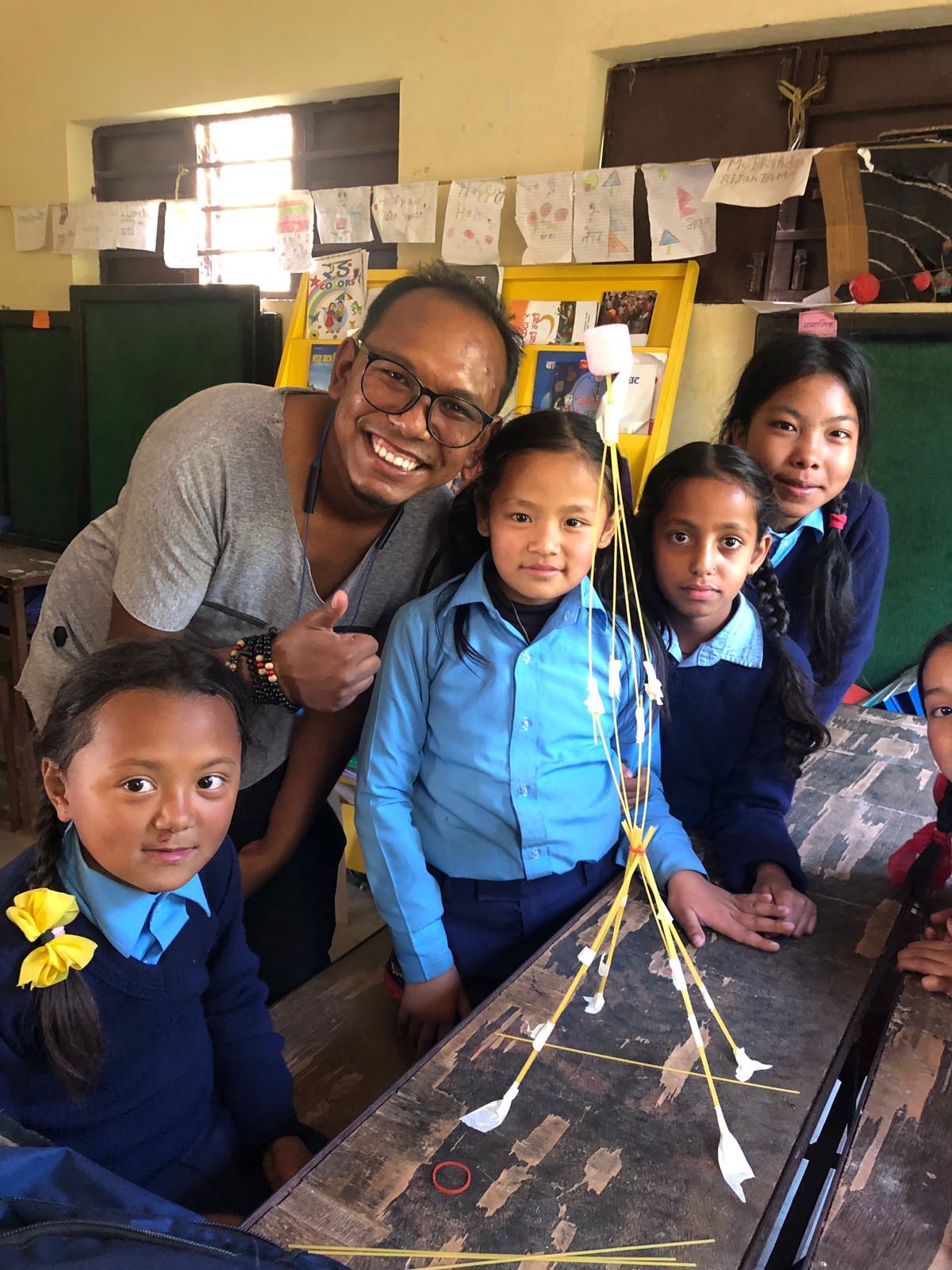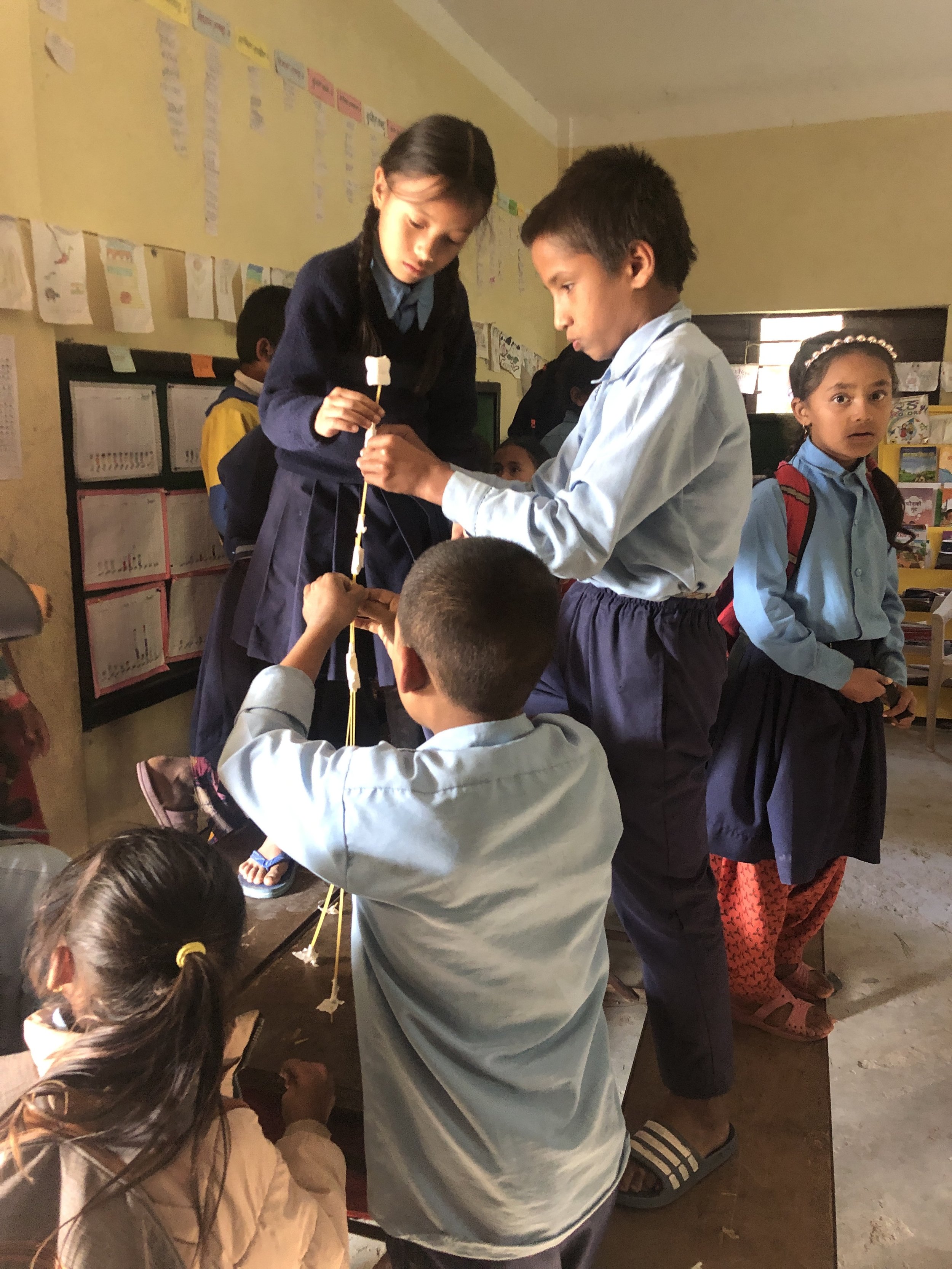Sending gratitude from a slightly bigger gratitude circle!
A group photo with some of our team members. We are grateful and lucky to have international volunteers again and as always grateful for our local, Nepali team of change makers!
Volunteers return to Camp!
It is the crisp, cool pre-winter season here in the mid-hill region of the Nepali Himalayas. Our team is growing as are our layers of clothes. This month marks the return of our first international volunteers back to our beloved Conscious Impact Sustainable Living Center, “Camp”.
The Langtang National Park and Mountain Range viewable from the village of Takure and a short walk from our Camp. This time of year presents daily gorgeous, clear sky and views of this Himalayan range. Photo by Jonathan H. Lee
Our team is so very happy to have the extra hands. International volunteers have always been a staple of our work - standing in solidarity with our community partners, supporting with their hands, energy, and resources. For the past 18 months, we have continued to operate our programs without these helping hands yet with the support of hundreds of donors. Nevertheless our staff has been eager to have diverse, kind people around again.
Our new volunteers arrived last month! We took a safe, private jeep from Kathmandu to Takure. Nepal’s restrictions have lightened for vaccinated tourist arrivals and we ask that every volunteer practices a 3 day self quarantine upon arrival to Kathmandu to ensure safety of our community partners in rural Sindhupalchok.
Our new arrivals jumped right into community activities with Tihar, the second biggest festival or holiday celebrated in Nepal and aligns with Diwali festival in India, both being recognized as the Festival of Lights. It is full of 5 days of festivities where each day is dedicated to a different ritual around animals and the goddess of Laxmi. This picture is from Bai Tikka the day where brothers and sisters give gifts and blessings to one another.
So, what has our team been up to?
In addition to clear skies, this time of year showcases the rice harvest, fruit and coffee tree care, the afterschool program, lemongrass, compost flipping, science projects, and the return of…
brick making!
Yes! We still produce Compressed Stabilized Earth Bricks (CSEBs). Well actually, the local social enterprise “Environmental Lover Brick Company“ run by Haribol Bhattarai and the team continues to produce bricks, and we partner with the team to ensure the bricks are produced safely and of high quality and can be affordable to local families. Since monsoon rains make brick production impossible, we usually start after the holiday season, sometime around early to mid November. The Earth Bricks are 100% locally made, seismically safe and the only locally available long-term, sustainable building material. Currently the team is producing bricks for our most loyal customer, the Janaki Thapa Foundation, a local foundation dedicated to supporting children and elderly in the region of Badegaun, about 1 hour drive from our site.
The Takure Earth Brick Production Center has been in operation since 2016 with the support of Conscious Impact’s donors. These bricks are made by a team of 10 local employees, 5 permanent and 5 rotational positions providing needed income and employment to 10 families. Photos by Jonathan H. Lee
The Janaki Thapa Foundation Home and Orphanage site in Badegaun, Indrawati-5, Sindhupalchok, Nepal. This site features a children’s home orphanage for 18 young children, space for elderly care, health clinics, a kitchen and living quarters for residential staff and visiting professionals, doctors and medical teams. The site has incorporated many features of a classic farm including a cow shed and a small-scale local chicken coop, plus areas for social gatherings including a play space, gathering space, alter for religious intents, meditation rooms, and more. They are currently building out a local hotel for visitors and teams to participate in their social programs.
Rice Harvesting
Rice harvest is always a favorite activity of visiting volunteers and during this season of harvest, there is a camaraderie around the village. Something that is felt when the community honors the same traditions that has been practiced by and fed this community for centuries.
Madhav Koirala, a local farmer in our cooperative, carries the bundle of rice stalks after they have been cut and dry. Photo by Jonathan H. Lee
Mela is word to describe the groups of farmer families that support one another in harvesting, planting, carrying rice. The system incorporates a social agreement where families support one another in the agricultural work. For example a local mela group may contain as many as 25 families - if the Gyanu Tamang family supports the rice harvest of Sunita Tamang family, then later when the Gyanu Tamang family is harvesting the same number of workers that supported Sunita’s harvest, will go to help Gyanu’s harvest. It is a labor exchange program that has been passed down for generations.
Supporting local farmers to plant fruit trees has always been about supporting their livelihoods so that they can continue to practice regenerative, organic, climate-resilient agriculture that feeds their families, communities, and country. That’s why we support them in activities like planting and harvesting rice too, building solidarity for their hard, necessary work as well as creating more connection of rice consumers to the producers. We believe that these relationships and awareness building programs are important to ensure future farming generations have access to secure livelihoods.
An aerial view of the rice production grounds. Photo by Jonathan H. Lee
The School Painting Program
Our School beautification project has a lot of popularity. We have partnered and completed 5 school painting programs and have another 7 schools waiting for their walls to be beautified!
We need painters and are actively looking among Kathmandu artists for volunteers to support this program. The schools in rural Nepal operate on very limited funds and restricted budgets, thus often cannot afford to improve the classrooms. That’s why we support them to do so! Our program paints bright and colorful learning materials on the walls of Early Childhood Development and Class 1 classrooms. The teachers are always appreciative and feel that the learning materials really helps them teach and supports the learning process of the students.
Tree planting and compost production
Our Agriculture Tree & Perennial program provided more than 15,000 kilograms of organic, quality compost for free this past summer! That’s more than 500 dhokos (baskets) of compost for those of you who have carried your share of dhokos full of compost.
15,000 kg of compost is a lot of compost! This compost helps farmers improve the quality of their soil and not take away compost from the other crops they grow. It was also provided as an incentive for local farmers. Growing trees is hard and different than the usual kinds of agriculture community partners participate in. Mostly it has a long waiting time to yield the benefits of their hard work - the harvest for coffee takes 4-5 years, the harvest for macadamia nuts takes 8-10 years, the non-grafted lemon, orange, avocado and other fruit take 5-7 years. For subsistent farmers, waiting that long is too much of a risk and pretty impossible, which is what our programs are designed to change.
After the free compost delivery, we worked individually with each farmer and created compost piles in their coffee and fruit tree fields, with the aim to increase their production of organic compost right in the very place it is used. Which means for all you compost carriers, less compost to carry! And also means cleaning up the overgrown grass in the coffee fields. A win win for all.
A view from above Udhav Kaphle’s coffee field. The upper canopy trees are Nepali Alder Trees which provide great shade and nitrogen nutrients to the coffee crop.
Udhav’s newly built compost field right next to his coffee tree orchard so he can easily give nutrients to the trees throughout the year.
Compost is a precious resource to farmers, especially when trying to grow organic fruit, nut and coffee trees! The photo on the right is a newly made compost pile - an equal mixture of cow or buffalo manure (if available), green grass, and brown leaves and sawdust and a bit of ash. The photo on the right is around 2.5 months later.
lemongrass and Conscious Crafts
Lemongrass farmers’ made their first harvests to be used for essential oil and natural soap production by Herb Nepal and sold as tea in Kathmandu.
This past monsoon, we helped farmers harvest their first batch of lemongrass, a pilot perennial herb we planted with a few farmers to test the growing nature and climate of herbs here in Takure and Bimire. Farmers were really pleased that lemongrass can be harvested twice per year and gives its first harvest within 50 days! That’s a very quick turn around for cash, something farmers are always in need of. We look forward to expanding this program! We were recently provided a higher quality variety of lemongrass for oil production by Herb Nepal, and farmers are very excited to plant next year. Additionally, we are looking at other types of herbs that can grow here to similarly distribute to local farmers and support their market access.
Farmer Chyangba Lama stands next to a organic lemongrass bush. He has planted around 80 plants and this past summer made nearly $80 USD on his harvest. That’s quite a good amount based on the 50 day harvest turnaround and the amount of work and maintenance required.
Dried, organic lemongrass for sale at Maya ko Chino store in Jamsikhel, Kathmandu. This store has hosted several products produced by community partners of Conscious Impact and we are always grateful for their support of local, authentic entrepreneurs. Check them out!
Coffee, coffee, coffee!!!
Coffee trees are FIVE and looking FINE.
It has been 5 years since we planted our first coffee trees, and htey look amazing! We are so excited to keep producing more delicious, local, organic, high mountain, Himalayan coffee and sharing it with the world.
The Aftershool Program
Afterschool Program kids build spaghetti towers to learn design, team work, and to eat the marshmallows!
Our afterschool program operates at the Takure Primary School twice a week with class 4 and 5 students, around 30 students aged 9-12 years old. Our team led by Youth Coordinator, Bishal Khaiju, works to develop hands-on, creative, learning activities for students that incorporates science, language development, creativity, and more. Currently our program is supporting the students to build a 3D model of their community. We explored maps, map history, google earth to introduce to the students the concept of a 3D map and the students loved it! On Google Earth, we visited around the entire globe, Kathmandu historical sites, the village of Takure and Bimire, Paanch Pokhari site, and Mt. Everest!






















